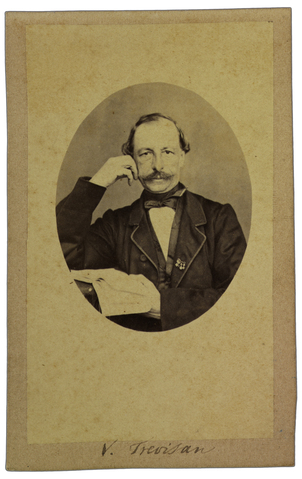Vittore Trevisan
 Vittore Benedetto Antonio Trevisan, earl of Saint-Léon, was born in Padua in 1818. His father Benedetto was a Paduan nobleman while his mother, Maria Anna Correr, was an offspring of an important noble Venetian family.
Vittore Benedetto Antonio Trevisan, earl of Saint-Léon, was born in Padua in 1818. His father Benedetto was a Paduan nobleman while his mother, Maria Anna Correr, was an offspring of an important noble Venetian family.
As usual among the nobility of the time, he received his first education from a private tutor and only later he attended high school and university in Padua, where he graduated in philosophy.
Since its youth, he became interested in botany, specializing in the cryptogamic flora and becoming one of the most eminent Italian lichenologists, so much so that during his long scientific activity he described 75 new genera of lichens. He distinguished himself above all for the attention he dedicated to the nomenclatural and taxonomic aspects, often coming to lively controversies with his contemporaries and above all with the Veronese Abramo Massalongo.
He produced 141 scientific publications, that also concerned fungi, algae, bacteria, vascular plants, bryophytes and general botany. His works include the Lichenotheca Veneta, an exsiccata publication issued in multiple copies and including 268 lichen samples.
Between 1851 and 1853 he was professor of natural history and “popular physics” in Padua and in 1882 he was appointed president of the physio-medical-statistical Academy in Milan; he was also a member of several scientific societies, awarded numerous honors and was a member of scientific commissions working mostly in the field of phytopathology.
Trevisan came to form one of the most impressive private Italian herbaria of the time, which he always made available for consultation by scholars. The first nucleus of this vast collection was the herbarium of the priest Girolamo Romano, which he received as a gift from count Nicola da Romano who had in turn inherited it. To this were added over time other private collections and individual specimens personally collected or given to him by illustrious contemporaries. At the count’s death in 1897, in Milan, the herbarium included over a million samples and was purchased by Giovanni Battista de Toni for the Institute of Botany at the University of Genoa. Unfortunately, the entire collection was destroyed by fire during the Second World War.